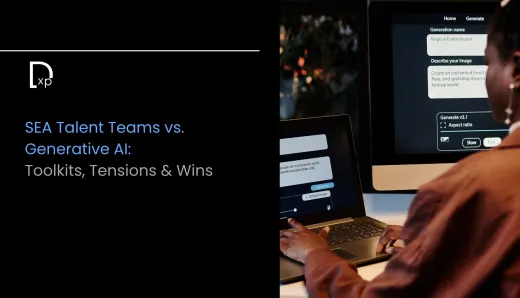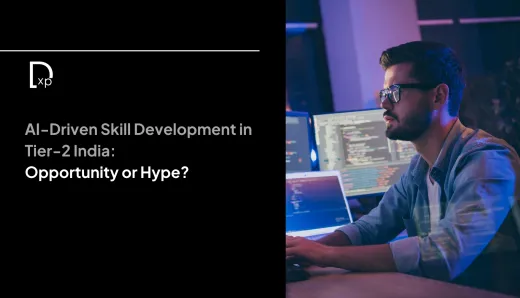The Ultimate Guide to Generative AI in HR (2025 Edition)

Generative AI is no longer a buzzword. It’s an enterprise capability that’s rewriting how HR teams hire, engage, and retain talent. As we step into 2025, HR leaders across industries are under pressure to drive measurable outcomes: faster hiring, deeper engagement, sharper insights, without bloating costs or headcounts. GenAI is not just making that possible. It’s redefining the rules of the game.
The companies pulling ahead are not waiting for pilots or sandbox tests. They are deploying generative AI tools in real workflows, with real outcomes, at scale. This guide breaks down what that looks like in practice and how your HR function can get future-ready, now.
Generative AI Is Not a Tool, It’s an HR Strategy
The biggest misconception about generative AI in HR is treating it like a shiny new app. It’s not. It’s a foundational layer that changes how your team writes job descriptions, screens candidates, builds engagement content, automates onboarding, and even generates learning paths.
In 2025, HR leaders must stop looking at GenAI as a helper and start treating it as a core capability. Whether it’s conversational bots in recruitment, AI-authored policy drafts, or auto-generated internal comms tailored by employee persona, the real power lies in how these tools stitch themselves into everyday workflows.
Recruiters Are Now Prompt Engineers
Speed is everything in hiring. But traditional sourcing is still stuck in outdated Boolean searches, resume databases, and vendor dependency. That’s changing fast. With generative AI, recruiters can now auto-generate role-based job ads, summarize resumes, compare profiles, and even simulate behavioral interview questions; all within minutes.
More importantly, these tools aren’t generic. With the right prompts, they can be tuned to your company’s tone, DEI goals, cultural traits, and success metrics. The result? A drastically shortened hiring cycle without compromising quality.
If your TA team still spends hours drafting job specs or screening resumes manually, you’re not just wasting time. You’re losing candidates to faster competitors.
Personalized Employee Experiences, Finally Delivered
For years, HR leaders have talked about personalization. But the reality? Most employees still receive templated onboarding decks, one-size-fits-all training, and generic engagement surveys. That’s because personalization at scale was impossible; until now.
GenAI enables real-time content generation tailored to roles, teams, geographies, even individual preferences. Imagine a new joiner in marketing getting an AI-generated onboarding journey based on their past experience, learning style, and current business unit. Or an internal mobility platform that creates career recommendations, not from static org charts, but from AI-mapped skills and aspirations.
This isn’t wishful thinking. It’s already being deployed by progressive HR teams using generative AI as a personalization engine, not just a writing tool.
Performance Management That Writes Itself
Mid-year reviews. Annual performance cycles. Calibration meetings. HR teams spend weeks chasing managers for inputs, structuring feedback, and aligning ratings. GenAI is eliminating much of this overhead by helping teams co-create performance summaries based on real data points, including, project outcomes, peer feedback, attendance, and pulse surveys.
What used to be a chore is now becoming a conversation. Managers can use AI-assisted templates to write better, bias-aware reviews. Employees can reflect with smarter prompts. HR can get consistent, structured feedback without endless follow-ups.
By 2025, performance conversations won’t disappear, but the paperwork around them will.
The Rise of the AI HR Business Partner
One of the most powerful shifts happening in 2025 is the emergence of AI-enabled HRBPs. Think of them as digital assistants that sit within HR and help with everything from policy clarification to real-time analytics.
Need a summary of exit trends from the last 6 quarters? GenAI pulls it in seconds. Want a new policy drafted in your org’s tone and format? GenAI gives you a compliant, editable draft. Want to understand why one region has higher attrition than others? GenAI can explore patterns in exit interviews, survey data, and manager comments.
This is not about replacing HRBPs. It’s about amplifying their strategic bandwidth by letting AI handle the noise, data, and documentation.
Compliance and Ethics Still Need Human Oversight
Let’s be clear; generative AI doesn’t absolve HR of accountability. If anything, it raises the bar. HR leaders must now put guardrails in place to ensure that AI-generated content is compliant with labor laws, free from bias, and aligned with company values.
This includes setting up approval workflows, audit logs, and governance frameworks that keep the human in control, without slowing down output. The best GenAI platforms for HR come with built-in content moderation, compliance checkpoints, and role-based access. Anything less is a risk.
In 2025, using GenAI responsibly isn’t optional. It’s a leadership imperative.
Getting Started: What Smart HR Teams Are Doing Now
The biggest mistake you can make in 2025 is waiting. Every delay means slower hiring, disengaged employees, and reactive HR operations. Smart companies are already moving on three fronts:
- Embedding GenAI into daily workflows, not treating it as a side project.
- Upskilling HR teams to work with AI tools, focusing on prompt design, content curation, and ethical oversight.
- Choosing platforms that integrate across systems, from ATS and HRMS to L&D and engagement tools.
The result is not just more automation. It’s more impact, with less chaos.
Final Word: This Is a Window, Not a Timeline
There is a short window in which early adopters of GenAI in HR will build a competitive moat, in culture, capability, and candidate experience. By 2026, this will no longer be optional, and the companies still evaluating pilots will be scrambling to catch up.
The question to ask is not “Should we explore GenAI?” The question is: “What’s the cost of not doing it now?”
If you’re a CHRO, Head of Talent, or HR Transformation Lead looking to deploy GenAI meaningfully, and responsibly, the time to start was yesterday.




